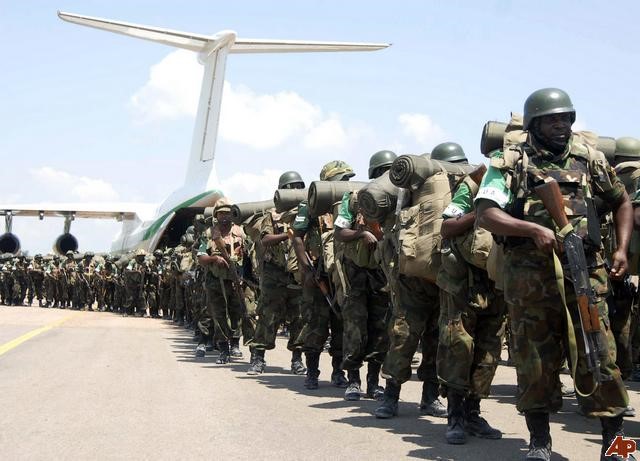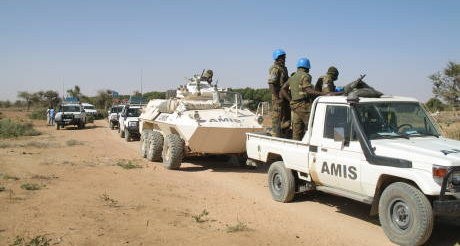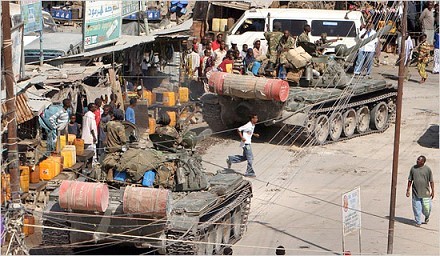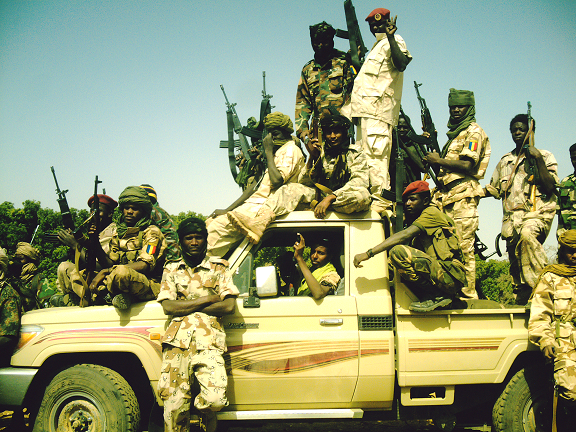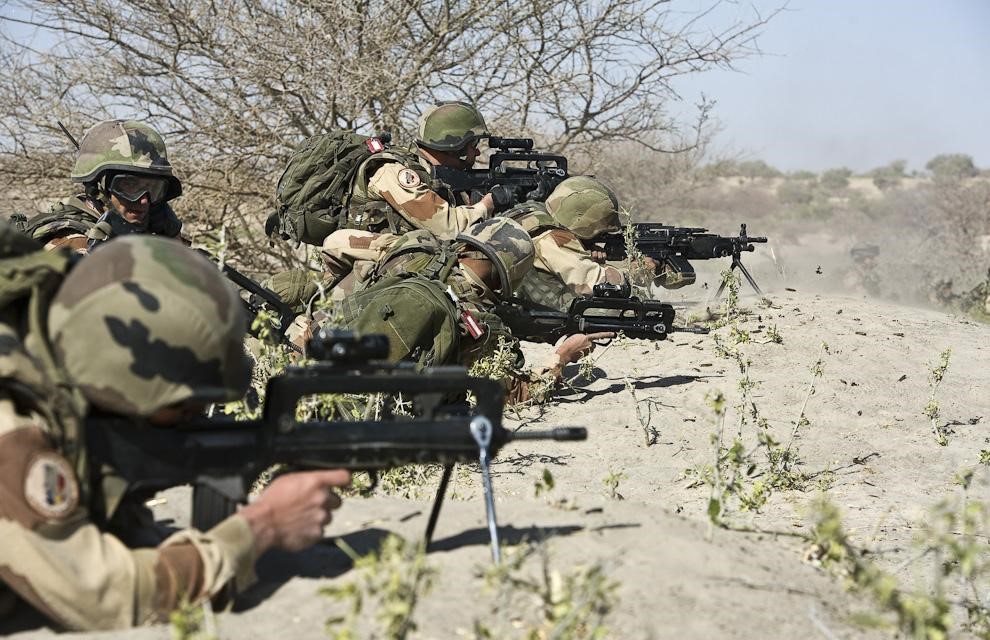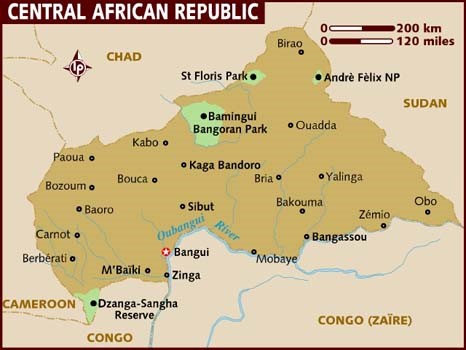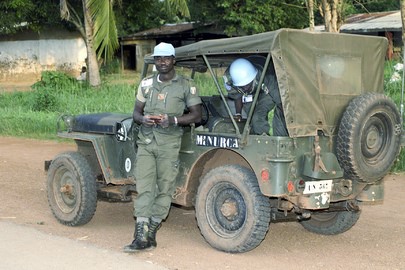Andrew McGregor
International Journal 54 (3) (Canadian Institute of International Affairs)
Summer, 1999 (pp. 482-501)
Following a long period of military rule, Ahmad Tejan Kabbah was elected president of Sierra Leone on 17 March 1996. Little more than one year later, on 25 May 1997, he and his democratically elected government were overthrown in a bloody coup led by dissident military officers and rebels from Sierra Leone’s long-standing insurgency. In March 1998, a peacekeeping force under Nigerian leadership, with considerable help from a British/South African mercenary firm and a local paramilitary (the Kamajor), entered Freetown, the capital of Sierra Leone, and restored Kabbah and his government. The motives for Nigerian intervention were twofold: there was a natural desire regional security; but General Sani Abacha also wanted international legitimacy for his discredited military regime. The initial success of the peacekeepers helped obscure some of the troubling aspects of the intervention – the lack of an international mandate, the use of mercenaries in peacekeeping operations, and the very undemocratic nature of the Nigerian regime. Peace has, however, eluded Sierra Leone: cities, towns and rural areas remain insecure and a supposedly defeated rebel army remains at large, indulging in a vicious retributive campaign of terror against a defenceless civilian population. Even though the situation remains fluid, the initial Nigerian intervention is worth examining both for the precedents it set and for the parallels with the current crisis in Kosovo – a large military power leading a sometimes reluctant regional alliance in a military campaign designed to bring an as yet undefined resolution to a civil conflict.
The assault on Freetown was apparently orchestrated by the Nigerian military without consulting their allies in the Economic Community of West African States (ECOWAS) and its military arm – the ECOWAS Monitoring Group (ECOMOG) – and without a United Nations Security Council mandate for decisive military action. Even though the offensive seemed well=planned, the Nigerian command described it as a spontaneous reaction to an attack by forces of Sierra Leone’s junta government, th Armed Forces Revolutionary Council (AFRC). While the United Nations, the Commonwealth and the Organization of African Unity (OAU) all called for the restoration of Kabbah’s legitimate government, the long-term intentions of the Nigerians remain uncertain. In the short term, their efforts to ease international opposition to the Abacha regime were at least partly successful, but still fell far short of expectations.
BACKGROUND
Sierra Leone is an example, unfortunately not unique, of a nation in which the collapse of political and social structures made external intervention appear the only humanitarian solution. It is a small ex-British colony in west Africa with dense forests, rich agriculture and abundant natural resources that would normally allow for a prosperous lifestyle for its citizens. Instead, it is ranked by the United Nations as the world’s most unliveable country. Since independence in 1961 successi9ive regimes have failed to deal with the collapse of a patrimonial system of wealth redistribution and the inequitable exploitation of the country’s natural resources. The resulting social tensions produced military governments and armed rebels (the Revolutionary United Front/Sierra Leone – RUF/SL) who shared a common origin in the ranks of disaffected and unemployed youths on the fringes of both urban and rural society. The military and the rebels have also shared a lack of vision regarding political reform or development in Sierra Leone, preferring to adhere to a programme of self-enrichment while passing through phases of confrontation and collaboration with each other.
The RUF rebellion was launched on 23 March 1991, 20 years to the day after the coup attempt for which its leader, Foday Sankoh, was jailed in 1972. Sankoh, once a corporal in the Sierra Leone Army (SLA), gained a thorough knowledge of the bush and forests of Sierra Leone during a stint as an itinerant photographer. Later training in Libya provided him with a background in the revolutionary arts. His movement developed out of a strain of revolutionary populism current in student circles in Sierra Leone in the 1970s and early 1980s. Its intellectual roots can be found in a blend of borrowed pan-Africanism and ideas from Muammar Khadafy’s Green Book.[i] These concepts would reappear as the slender ideological core of Sankoh’s revolutionary movement.
The obscure ideology that drives the RUF is of little help in explaining some of the movement’s questionable strategic decisions. The decision to join forces with the military junta in May 1997 provided the backbone for the junta’s struggle to retain power but also gave Nigeria the opportunity to impose a political/military solution on the Sierra Leone crisis. The RUF has also consistently failed to present a coherent political agenda to the international community. In its first real chance to address an international forum (the OAU-RUF meeting in Abidjan on 3-4 December 1995), the RUF delegation stressed that its target was not so much the ruling National Provisional Ruling Council (NPRC) as the prevailing ideology of corruption, which it viewed as a legacy of the All People’s Congress that had ruled Sierra Leone from 1968 to 1992.[ii] The delegation favoured postponing elections and made the rather startling declaration that Foday Sankoh “did not want to be the President of Sierra Leone and his only wish was to see Sierra Leone liberated.”[iii]
The current troubles in Sierra Leone can be traced back to the 1990 ECOMOG intervention in Liberia. As Sankoh began organizing his movement, Charles Taylor, the Liberian guerrilla leader, began to arm the RUF in retaliation for two battalions of the SLA which Sierra Leone provided to help the Nigerian-led ECOMOG forces in Liberia. The fighting strength of the early RUF depended heavily on Liberian and Burkinabe mercenaries, fighting mostly for plunder, with little sense of responsibility to the Sierra Leonans for whom they were putatively fighting. Charles Taylor, with some justification, saw ECOMOG as a Nigerian-inspired effort to rescue Samuel Doe, the Liberian president, whose authority at the time did not extend beyond the walls of the presidential compound in Monrovia.
The scant access of the rural-based RUF to communications to the outside world and Sankoh’s inexplicable reluctance to take advantage of every opportunity to express his position at international forums (in December 1996, for example, he refused to meet with United Nations negotiators in Sierra Leone) left the international community in the dark over the motives behind the brutalization of the civilian population of Sierra Leone. Those foreign capitals that took the time to consider the RUF found it lacking in credibility as an opposition movement. They hoped that the democratic election of Kabbah in 1996 would put an end to the relentless devastation of the country by rebels and state security forces alike.
Sankoh eventually agreed to outside mediation in negotiations with the newly elected president. With assistance from the government of Côte d’Ivoire and the participation of the OAU, the United Nations, the Commonwealth, and the International Red Cross, the Yamoussoukro communiqué was issued in April 1996, and in December the Abidjan agreement called for a ceasefire and “a framework to further the process of democratization and equitable social and economic development in Sierra Leone.”[iv]
The military coup in Freetown in May 1997 brought to a halt the implementation of the Abidjan agreement. At the time, Foday Sankoh was in detention in a luxury hotel in Nigeria where he had been arrested in February. Educated but non-combatant members of the RUF leadership had expelled Sankoh from the movement two weeks before his arrest, but the expulsion carried no weight with the fighters and battle-commanders, who remained loyal to him. Those responsible for his expulsion were abducted from a reconciliation meeting in early 1997 and have not been seen since.
Likely under Sankoh’s advice, the battle-commanders brought 500 rebels (many boys as young as 12) to Freetown at the invitation of the coup leaders, who believed they faced imminent foreign military intervention. The RUF decision to enter into a defined military alliance with the coup leaders brought the RUF out into the open where it could be crushed by conventional military force, a costly defiance of all traditional guerrilla strategy – RUF success had always been based on avoiding direct confrontation with government forces. The result was the elimination of much of the movement’s leadership and a good portion of its arms.
THE JUNTA GOVERNMENT
The coup that precipitated the ECOMOG military intervention began with an assault on Pademba Road Prison in Freetown, from which Major Johnny Paul Koroma was released, together with 600 felons and veterans of unsuccessful coups. Koroma was a member of the politically powerful Limba tribe of Sierra Leone’s Northern Province. His trial for participation in a September 1996 coup attempt was set to begin one day after he was released from prison. Although close to the leaders of the 1992 coup of Captain Valentin Strasser, Koroma’s only significant field operation was looting the vehicles of the mining operation he was supposed to be guarding from RUF rebels.
Twenty members of the new Armed Forces Revolutionary Council (AFRC) were named on 1 June 1997. They included Foday Sankoh as (absentee) vice-chairman, RUF chief strategist Sam “Mosquito” Bockarie, and two other RUF members. Koroma’s brother, Brigadier S.F.Y. Koroma, was appointed chief of staff, while Solomon “Saj” Musa, the feared ex-security chief in the 1992-96 NPRC military government, became chief secretary. Junta leadership was dominated by the Limba tribe (10 per cent of the Sierra Leone population) and the northern Temne (25 per cent of the population). Other members were generally young, unknown, poorly educated junior officers and non-commissioned officers, most of whom had benefited from inflation in the ranks when the SLA grew from 8,000 to 12,000 men after the 1992 coup. Many of the new recruits were street children and petty criminals.
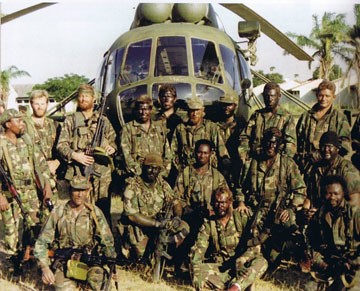 Executive Outcomes Mercenaries in Sierra Leone
Executive Outcomes Mercenaries in Sierra Leone
The army eventually grew to a strength of 14,000 before the 1996 Abidjan agreement called for a 50 per cent reduction in its numbers. Though poorly trained and incapable in the field, the SLA was not happy when the South African mercenary firm, Executive Outcomes, was engaged to provide security in the mineral fields, the government promoted the Kamajor militia, and Kabbah chose Nigerian troops for his personal bodyguard. Many of the rank-and-file expressed their dissatisfaction by becoming part of the “Sobel” phenomenon – “soldiers by day, rebels by night.” The high level of resentment reached the senior ranks of the SLA: even the chief of staff, Hassan Conteh, gave his support to the junior officers’ coup.
A national “People’s Army” was formed soon after the coup from 8,000 SLA regulars and 5,000 RUF guerrillas. They were initially effective in holding off Nigerian forces in the Freetown area. In response to a Nigerian naval bombardment of Cockerill military barracks on 2 June, 3000 Nigerian troops were disarmed and taken hostage, an action that brought an early end to negotiations between the AFRC and the Nigerian high commissioner, Chedi Abubakr.
As well as the SLA and the RUF, there were two other active armed groups – the mercenaries and the Kamajor militias. The approximately 5,000 Kamajor, or “traditional hunters, have proven to be deadly opponents of the junta and the RUF. A rural militia, they combine bullet-thwarting talismans, traditional hunting skills and mercenary-provided military training in support of their leading civilian patron, Tejan Kabbah. They are drawn mainly from the Mende tribal group (about 25 per cent of the population and Kabbah’s biggest support-base). Sam Hinga Norman, a cabinet minister, important supporter of Kabbah, former Kamajor leader and long-time Executive Outcomes lobbyist, has played an important role in co-ordinating Kamajor training by mercenary units.
The hunters’ militia was already active against the RUF before the Koroma coup, fighting for control of coffee and cocoa plantations in the Kailahun District of eastern Sierra Leone. At the time, Kailahun was run as a mini-state by Foday Sankoh and was the centre for his trade in agricultural products and diamonds with merchants from Liberia and Guinea. Considering the hostility of the RUF and the resentment of the often unpaid SLA of the highly funded Kamajor militia, it was hardly surprising that the AFRC’s first official announcement was a ban on Kamajor activities. Open conflict followed swiftly as the junta forces attempted to disarm the militias, but the Kamajor were highly successful in operations against the “People’s Army” in southeast Sierra Leone, often with the benefit of superior weapons supplied by Nigeria. After Kabbah’s restoration, the Kamajor militia seized the provincial towns of Bo and Kenema, executed soldiers of the People’s Army and put the homes of AFRC backers to the torch.
THE MERCENARY ROLE
The 1992-96 NPRC government had engaged a force of Gurkha mercenaries to combat the RUF, but these troops became demoralized after the death of their commander and returned home. In their place came a number of South African and British “security” firms, on both government and private contracts. Executive Outcomes, a South African firm, proved very successful in action against the RUF, but was officially withdrawn from Sierra Leone on 3 February 1997 under the terms of the Abidjan agreement. Control of Sierra Leone’s prosperous diamond fields was considered essential by all parties to the conflict, as well as by the private mining companies. After the coup, Lifeguard (an affiliate of Executive Outcomes) was hired by Branch Energy Limited (a subsidiary of Canadian-owned Diamond Works) and two other mining operations. Two British mercenary groups were also active, Defence Systems Limited and Sandline International, which played a crucial part in the ECOMOG offensive against the junta.[v]
Recent revelations have confirmed earlier speculation[vi] that the restoration of the Kabbah government was carefully planned by Kabbah, senior Nigerian staff officers and Sandline International. In early May 1998, in response to a British Customs and Excise probe into Sandline’s alleged involvement in supplying weapons and military expertise to pro-Kabbah forces in violation of a United Nations arms embargo, Sandline’s lawyers released a letter listing numerous officials in the British and American governments who were fully briefed in advance about the March assault that expelled Koroma’s junta.[vii] The resulting “Arms to Africa” scandal proved a major embarrassment to Robin Cook, the British foreign secretary.
In a letter released on 12 May 1998, which was intended to support the besieged British Labour government, Kabbah stated that he had neither asked for nor received any military assistance from Britain and that the role of Sandline International in his restoration had been exaggerated. The letter unfortunately appeared the same day as press revelations that a major in the Scots Guards had been decorated by the Queen for his part in defending a position held by a pro-Kabbah militia against AFRC forces. The Financial Times claimed to have independent eyewitness accounts that the major was fighting alongside eight white mercenaries at the time.[viii] The permanent secretary to the Foreign Office, Sir John Kerr, was compelled to admit on 14 May that Lt Col Spicer of Sandline had regularly briefed senior Foreign Office officials about the situation, contrary to previous assertions that only junior officials had had some minor contacts with the Sandline chairman. The prime minister, Tony Blair, praised the work of the high commissioner to Sierra Leone, Peter Penfold, who was accused of working closely with the Sandline mercenaries, possibly with the encouragement of British intelligence agencies. Blair later claimed, in what seems a tacit admission of official British involvement, that Britain had been right to help restore the democratic government of Tejan Kabbah.[ix] Unfortunately for Nigeria, the emergence of the “Arms to Africa” scandal overshadowed its operations in Sierra Leone; operations which were, after all, designed to display a capable and benevolent image of the Nigerian regime to the international community.
ECOWAS and ECOMOG
Sandline’s collaboration with what was ostensibly a peacekeeping mission raises questions about the direction Nigeria has taken regional peacekeeping and the impact this has had on ECOWAS and ECOMOG. Almost from the beginning, the Nigerian role in Sierra Leone was one of intervention rather than peacekeeping. Nigeria frequently claimed that it had the full blessings of the United Nations, the Commonwealth, and the OAU as it gradually dropped any pretense of impartiality in the Sierra Leone power struggle. The Nigerian plan seems to have been to use military pressure to force on the ruling AFRC a diplomatic solution favourable to Nigeria; if that failed, the option of a direct strike with overwhelming force remained open. In pushing for a solution it desired, Nigeria made full use of its size and economic dominance of its ECOWAS partners – its population of 107 million exceeds the combined population of the other 15 ECOWAS nations, while its gross national product is only slightly less than that of its partners combines.
As justification for its interventionist approach, Nigeria cited the 1981 ECOWAS Protocol Relating to Mutual Assistance.[x] The relevant sections of the protocol are article 2 – “Member states declare and accept that any armed threat or aggression directed against any member state will constitute a threat or aggression against the entire Community” – and article 16 – “When an external armed threat or aggression is directed against a member state of the Community, the Head of State of that country shall send a written request for assistance to the current Chairman of the Authority of ECOWAS.” When a written request from Kabbah for intervention in Sierra Leone was receive in Abidjan, the Nigerian government was satisfied that the necessary conditions for direct action had been met.
The original purpose of ECOWAS was to promote economic integration amongst the disparate Anglophone, francophone and lusophone nations of west Africa. The organization is currently in financial peril; only Nigeria, Benin and Côte d’Ivoire are fully paid up members. Efforts at economic and monetary union have largely failed, distrust between Anglophone and francophone members has resurfaced, and organizations such as the European Union that once took a great interest in ECOWAS’s success have begun to divert their funds and energies to the more promising Southern Africa Development Community.
ECOMOG, the military arm of ECOWAS, was formed in 1990 to present a united front in the Liberian crisis. Increasingly, it has become the most active part of ECOWAS, even though many ECOWAS members have little or no participation in its operations. Nigeria has inevitably dominated ECOMOG, but a poor effort by the government to inform the population at home about the intent or value of Nigerian peacekeeping efforts has led to indignation over the large expenditure of national resources required to maintain such forces and to a number of popular campaigns to reduce Nigeria’s prominence in ECOMOG.[xi]
The original ECOMOG mission in Liberia quickly incorporated elements of peacekeeping and peace enforcement. Charles Taylor (now president of Liberia) refused to accept the legitimacy of the mission, especially as it seemed designed to halt what looked like the inevitable military victory of Taylor’s forces in 1990. After heavy fighting between ECOMOG and Taylor’s National Patriotic Front of Liberia (NPFL), the supposed impartiality of the ECOMOG forces was open to question. The mission tended to look more like a relief force for Samuel Doe, a close personal friend of Nigeria’s president, Ibrahim Babingida.
So far, ECOMOG forces have, for the most part, avoided the severe ruptures between the field commands of member-states that occurred in the underfunded OAU peacekeeping mission in Chad (1981-82),[xii] largely because Nigeria underwrites nearly the entire cost of the mission. The other ECOWAS states that provide combat troops to ECOMOG (Ghana Gambia and Guinea) have long-standing ties to Nigeria.
On 26 June 1997, the ECOWAS community took its first steps towards a diplomatic solution to the crisis in Sierra Leone. The foreign ministers meeting in Conakry declared their willingness to use dialogue, economic sanctions or military action to restore the elected government. A Committee of Four (Côte d’Ivoire, Ghana, Guinea, and Nigeria) was established to oversee the process. (Liberia as a late addition made it a committee of five). Their recommendations were endorsed at the 20th ECOWAS summit, and a wide range of sanctions was implemented against the AFRC regime. Use of force to remove the Koroma regime was initially backed by Gambia ad Guinea, while Côte d’Ivoire and Ghana (temporarily) led the call for a negotiated settlement.
Contacts between the junta and the Committee of Five (led by Nigeria’s foreign minister, Tom Ikimi) had some results. The Conakry peace agreement of 23 October 1997 called for an immediate cessation of hostilities, a monitored disarmament, recognition of Foday Sankoh’s leadership role, a broadening of the power base, and the restoration of the constitutional government of Tejan Kabbah by 22 April 1998. Unfortunately, considerable pressure from the RUF faction of the junta led to the effective scuttling of the agreement in December 1997 when Koroma issued a new set of condition, including the release of Sankoh, a reduction in the Nigerian contingent of ECOMOG in Sierra Leone, and full control of the disarmament process by the SLA.
After Freetown was taken and the AFRC junta was eliminated, Ghana and Gambia publicly approved the ECOMOG action, but other ECOWAS state resisted Nigeria’s claim that its mandate for Liberian peacekeeping now extended to Sierrra Leone. Liberia refused to turn over RUF fugitives who had fled from ECOMOG forces and complained that arms obtained by Executive Outcomes were transported by ECOMOG forces through Liberia on their way to pro-government Kamajor militias in Sierra Leone.
Ghana is seen as a moderating influence on Nigerian ambitions, and its continued involvement in the Sierra Leone peacekeeping force is strongly encouraged by Britain and the United States. Further Guinean military involvement in ECOMOG can also be expected, especially as Guinea has security concerns about a rebel movement operating from the Sierra Leone side of their common border. Aside from Guinea, however, most francophone members of ECOWAS (Benin, Burkina Faso, Côte d’Ivoire, Mali, Mauritania, Niger, Senegal and Togo) are reluctant to become involved. Some have questioned Nigeria’s sudden opposition to regional military coups when it gave every indication of welcoming Captain Yahya Jammeh’s 1994 coup in Gambia and because it has its own notorious history of military coups.
THE ROLE OF THE UNITED NATIONS
The United Nations’ response to the Sierra Leone crisis may be described as ambiguous and reactive at best. Chapter VIII of the United Nations Charter describes recourse to multipurpose regional security organizations, although their main roles are mediation and arbitration. In 1995 the Joint Inspection Unit recommended that regional organizations should be encouraged to form the first resort for resolution of local conflicts.[xiii] Article 53 of the Charter would seem to require explicit authorization for the use of force: “no enforcement action shall be taken under regional arrangements or by regional agencies without the authorization of the Security Council.” The closest the Security Council came to such an authorization was on 8 October 1997 when it adopted a resolution empowering ECOWAS to impose oil and arms sanctions against Sierra Leone. The ensuing Nigerian naval blockade and occupation of Freetown’s Lungi International Airport proved very effective; AFRC government revenues fell by almost 90 per cent. In addition, all foreign aid (normally 30 per cent of the national budget) was halted. Some weapons were successfully smuggled to the regime in Freetown, along with Liberian recruits to the “People’s Army” and a dozen Ukrainian mercenaries,[xiv] but the smuggling was dealt with forcefully; the Nigerian navy shelled Freetown’s port in August 1997, killing 30 people.
A situation in which an arms embargo was authorized by the Security Council but the use of military force was not was identical to the situation in Liberia in 1992 when Nigerian-led ECOMOG forces took the initiative for military action. Winrich Kühne has noted the lesson that Nigeria must have absorbed from this earlier experience: “the political message of the Security Council’s behaviour is clear: if the leading powers in the Security Council are loath to involve the UN or themselves in a regional conflict, regional powers and regional arrangements will not have to worry about the stringent application of the authorization clause in Article 53 of the UN Charter.”[xv]
The almost total embargo on arms, fuel, food, and medical supplies went well beyond the official mandate but was doubtless encouraged by the equivocal remarks of the United Nations secretary general, Kofi Annan: “Where democracy has been usurped, let us do all in our power to restore it to the people. Neighbouring states, regional groups and institutional organisations must all play their parts to restore Sierra Leone’s constitutional and democratic government.”[xvi]
In early 1997, prior to the Koroma coup, the United Nations Security Council was divided over the value and expense of an official United Nations peacekeeping force in Sierra Leone. The reluctance of the RUF and the Sierra Leone government to implement the November 1996 peace accord and the continued instability within Sierra Leone were noted as impediments to deploying a peacekeeping force. A small observer mission was eventually settled on, which it was hoped would meet with more success than the United Nations Observer Mission in Liberia (UNOMIL), an earlier and largely unsuccessful effort at co-ordinating United Nations and ECOMOG activities.[xvii]
THE OAU AND COMMONWEALTH ROLES
As for the OAU, the Nigerian intervention was welcomed by its chairman, Robert Mugabe, and its secretary general, Salim Ahmed Salim, at the Zimbabwe summit in June 1997. A later ministerial meeting in Addis Ababa gave its support for sanctions and the imposition of an embargo. It also called, unsuccessfully, for United Nations financial and material support to ECOWAS efforts.[xviii] Ever since its embarrassment over the failure of its first and only attempt at peacekeeping in Chad, the OAU has been reluctant to initiate peacekeeping operations. Despite recent interest from the United Nations, the Western European Union (WEU), the United States, and France in establishing a permanent pan-African peacekeeping force under OAU direction, such a force is unlikely to develop without a solid and continuing financial commitment from external sources. Meetings of OAU military chiefs of staff in Addis Ababa in 1996 and Harare in 1997 confirmed that “the OAU’s main responsibility should be to anticipate and prevent conflicts but that, in exceptional circumstances, the OAU should deploy limited peace maintenance and observer missions.”[xix]
Despite Nigeria’s lengthy peacekeeping experience in Liberia, Sierra Leone, and lately, Guinea-Bissau, the question remains open as to what role, if any, Nigeria will have in a proposed United Nations/OAU peacekeeping force. So far it has not been involved in planning for the force, but it is difficult to envision this type of regional force without Nigeria’s clout and experience. The question if whether the Nigerian practice of unilateral decision-making at staff-level and unsanctioned use of force in the field will prove a useful contribution to such a force. The direction of a new democratic government in Nigeria and the success or failure of Nigerian field forces in Sierra Leone will eventually provide the answer. Nigeria’s president, General Olusegun Obasanjo, supports a continued military role in Sierra Leone (with extensive British financing) for the time being.[xx]
Although the Commonwealth secretary general, Emaka Anyaoku, claimed that military intervention was “totally justified,”[xxi] the Commonwealth nations are divided over their treatment of Nigeria’s role in Sierra Leone. Nigerian expectations of being welcomed back to the Commonwealth following a successful restoration of the Kabbah government met with strong opposition from Canada and Britain. Nevertheless, the Abacha regime had allies within the Commonwealth, notably President Jerry Rawlings of Ghana. Rawlings spoke on behalf of Nigeria as a proponent of ECOMOG activities in Sierra Leone, despite domestic opposition and a number of outstanding bilateral differences between the two countries. When Britain condemned Nigeria’s actions at the 2 March 1998 meeting of the Commonwealth Ministerial Action Group, Ghana turned the condemnation into a statement of approval for ECOWAS operations (without mentioning the Nigerian-dominated ECOMOG). Britain has, nevertheless, committed substantial funds for both further ECOMOG activities and a disarmament and demobilization programme aimed at re-integrating rebels into Sierra Leone society.
THE NIGERIAN ROLE
Nigeria became a key mover in the ECOWAS/ECOMOG alliance not only because of its size but also because of its domestic economic crisis and the political isolation of the Abacha government. Nigeria has a US$34 billion external debt and has so neglected its petroleum facilities that, even though it produces 1.5 million barrels of oil per day, it has a perpetual fuel shortage. Political strife in the oil-rich Niger delta also severely reduced output in the last year. Despite financial mismanagement, endemic corruption and political intransigence in the democratic transition programme, the Abacha regime continued to receive mixed signals from the West. The last year of Abacha’s rule witnessed a growing rapprochement between Nigeria and France, which was seeking a new partner in west Africa after the overthrow of Zaire’s Francophile Mobutu government. Relations between the two have been strained since de Gaulle supported the Biafran secessionists (1967-70), but Abacha tried to make French Nigeria’s second language and moved its European oil headquarters from London to Paris. In an effort to win friends within ECOWAS, he awarded lucrative crude oil contracts to most of the francophone members who traditionally oppose Nigeria’s dominant role in the region.
Before his death on 8 June 1998, Abacha no longer trusted his military power base. ECOMMOG service was presented as a carrot to disaffected military units or officers; Nigerian troops on active ECOMOG duty are paid according to the ECOMOG pay-scale, a substantial improvement on the salary they could expect in Nigeria. ECOMOG service had the added benefit of keeping suspect units and officers out of the country for extended periods. Unofficially, service abroad also offered the chance for some unsanctioned looting – in Liberia ECOMOG was said to stand for “Every Car Or Moveable Object Gone.”[xxii]
Nigeria’s barely covert collaboration with mercenaries in the restoration offensive marked a full turn in Nigerian policy; it had reacted with outrage to the activities of mercenaries on its soil during the Biafran insurgency. Further revelations of deep mercenary involvement in the campaign threatened even the limited credibility the military regime had accrued through its costly intervention in Sierra Leone. After its initial military setbacks, the Nigerian command no doubt felt the need for external expertise which was, however, unavailable from United Nations, Commonwealth, or OAU sources.
THE POLITICAL FUTURE
The success of Nigeria’s efforts to restore stability to Sierra Leone will be severely tested in the coming months because the root causes of instability remain. Though the Nigerian assault on Freetown quickly achieved its military objectives, the unexpected depth of resistance was a clear indication of further turmoil. Mercenary activities are likely to continue for some time; Sierra Leone is still a long way from being able to provide effective internal security, the Nigerian military has no objection to mercenary security operations, and the security firms themselves are widely believed to have traded their services for financial interest in mining operations within Sierra Leone, lending credence to the belief that they are there for the long haul. New government-issued mineral contracts will likely contain stipulations for private security.
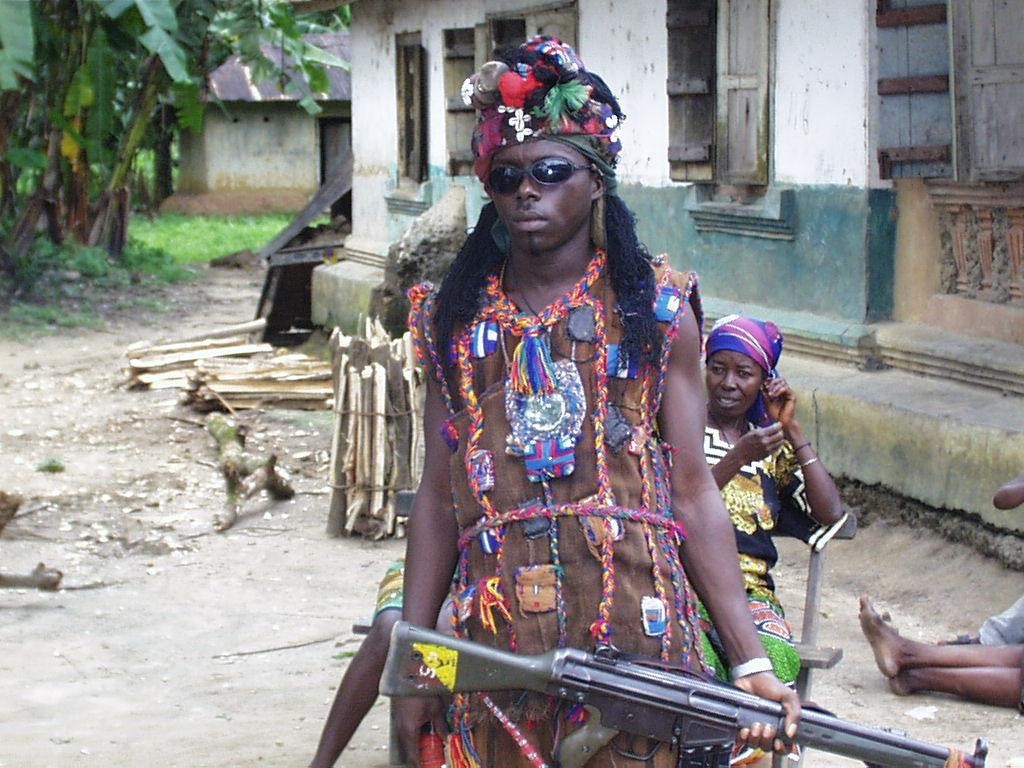 Kamajor Fighter
Kamajor Fighter
On 13 July 1998, the Kabbah government disbanded what remained of Sierra Leone’s standing army and began recruiting a small “reformed” armed force, but the loosely disciplined Kamajor militia remained the government’s strongest domestic defendant. Since the restoration of their patrons, Kabbah and Norma, the Kamajor have directed their operations against the Limba and other northern tribes who were seen as supporters of the junta. The militia appears to have had little impact on the RUF’s terror campaign; when the two forces do clash, the frontline fighters on both sides are usually well-armed and drug-stimulated children.
If a peace agreement can be reached between the RUF and the government, the Nigerians can still expect a lengthy stay. Even a reformed SLA cannot be expected to provide an effective level of security in the foreseeable future. The Kabbah government hardly returned to a hero’s welcome from many of the loyal Sierra Leonans who had to endure the privations, looting and violence of the Koroma regime. The bombardment of Freetown in early February 1998 by Nigerian jets and heavy artillery was little appreciated by those residents who opposed the AFRC regime, and blame for the destruction was eventually laid by many at the feet of Kabbah. A prolonged stay in Sierra Leone may well suit some factions within the Nigerian military who have an interest in the country’s mineral wealth and in helping Nigeria contain the regional ambitions of Liberia’s Charles Taylor. A Nigerian presence in Sierra Leone is unlikely to meet serious Western opposition if the alternative is the insertion of a Western-based peacekeeping force.
That a continued international military presence is desirable is shown by the random vengeance exacted upon the rural population by surviving RUF units through 1998 and early 1999. Far from being a spent force, the RUF has conducted a ruthless campaign of indiscriminate terror in the interior (codenamed Operation No Living Thing), amputating the hands and feet of thousands of rural civilians, including children, before striking into the heart of Freetown again in early January 1999. Apparently concluding that international acceptance for the movement was irrevocably lost after their initial defeat in Freetown, the RUF opted to surpass the worst excesses of its earlier terror campaigns and developed into a personality cult revolving around its imprisoned leader, Foday Sankoh.[xxiii] The ability of the rebels to penetrate the capital, commit major atrocities, and send government leaders fleeing to the ECOMOG airbase north of the city was a major blow to Nigerian military prestige and forced the Sierra Leone government to open negotiations with Sankoh, even though it had sentenced him to death after Kabbah’s restoration. The events of the last year have produced widespread alienation amongst potential RUF supporters and deepened the enmity amongst its traditional foes.
CONCLUSION: REPRISALS IN SIERRA LEONE AND POLITICAL OPENING IN NIGERIA
That the Nigerians have pegged their national prestige and reputation to the success of their ECOMOG activities can be clearly seen. The interim government of General Abusalam Abubakr pledged to commit 20,000 men (a quarter of the Nigerian army) to operations in Sierra Leone even as the 1999 Nigerian budget forecast a 54 per cent drop in revenues because of sharply reduced petroleum prices.[xxiv] Since the initial success of ECOMOG forces in restoring the Kabbah government, the intervention has had its weaknesses exposed through allegations of illegal arms transfers to loyalist forces, its inability to provide effective security in rural or urban areas, the pursuit of an internationally condemned policy of lethal reprisals by the government, and the incursion into Freetown by supposedly defeated rebels.
The seriousness of the continuing crisis, the obvious need for armed intervention, and successful democratic elections in Nigeria in February have tended to bring the international community on side with Nigerian efforts (together with its ECOMOG and mercenary allies) to preserve Kabbah’s tenuous presidency. While backing off from Abacha’s growing partnership with France, the Abubakr transitional regime made successful representations to the annual International Monetary Fund/World Bank meeting in the autumn of 1998 and convinced Canada to restore diplomatic relations after a two-year suspension.[xxv]
A leading point of contention between Kabbah’s government and elements of the international community is the policy of retaliation against former army officers, captured rebels, and their alleged civilian collaborators. After Kabbah’s government was restored, over 5,000 accused collaborators were arrested and over 100 civilians and military officers were charged with the capital offense of treason. On 8 April 1998, the government suspended the Criminal Procedures Act so that suspects could be tried quickly under emergency regulations. In defence of the alleged collaborators, the London-based Alliance for Peace and Democracy in Sierra Leone pointed out that several leading government members, including Kabbah, had accepted public appointments under the illegal NPRC military regime. According to the Alliance: “No one charged them with treason or aiding and abetting. It seems ironic therefore that these same people now leading a civilian government see it fit to charge with capital offence civilians who found themselves in exactly the same positon as they did.”[xxvi]
Despite international appeals for clemency, executions were carried out by Nigerian ECOMOG members. On 19 October 1998, 24 army officers, convicted without appeal, were executed in Freetown. The dead included the former chief of staff, Conteh, and Col. S.F.Y. Koroma. At least one of the condemned expressed bewilderment at the role of the Nigerian; the last words of Col. David Anderson were: “So you Nigerians came here to kill us while you have more coups in Nigeria than any other country?”[xxvii]
Once begun, popular pressure for continued executions as the RUF carried out daily atrocities in an attempt to free Sankoh began to give the reprisal programme a life of its own, making it almost impossible for the government to back down, even if it were so inclined. Sankoh was returned to Sierra Leone from Nigeria in July 1998 and was sentenced to death on 23 October after a short trial in which he was unrepresented by counsel; no lawyer could be found in Sierra Leone willing to defend him. Documents presented during the trial indicated a continuing Libyan connection in the form of a RUF funding pipeline through the Libyan People’s Bureau in Ghana.[xxviii]
The Nigerian experience demonstrates that although the United Nations Charter appears to recommend the use of regional and sub-regional peacekeeping organizations, no effective framework exists for those organizations to report to a wold body such as the United Nations or to seek its approval for actions in the field. The Nigerian regime exploited this situation to further its own regional and international interests, always keeping one step ahead of what had been sanctioned by ECOWAS, the OAU, the Commonwealth, and the Security Council. So long as decision-making in peacekeeping policy continues to be made on the basis of winks and nods from members of the international community, rather than on the basis of verifiable resolutions and authorizations, the resulting operations will hold little credibility and will remain open to legitimate challenge from any of the involved parties.
Nigeria has demonstrated an affinity for a unilateral approach to regional peacekeeping, using its wealth and military power to drag its ECOWAS partners along with it. If the result of such unilateral action happens to coincide with the aims of the international community, as in Sierra Leone, the international response is bound to be confused. The new realpolitik from Britain’s foreign secretary (almost prophetic in light of Britain’s energetic defence of NATO’s unsanctioned intervention in Yugoslavia) was that “nobody should lose sight of the fact that the outcome of what happened was positive.”[xxix] Abacha was able to exploit these mixed signals to a certain extent in his attempts to regain international acceptance, if not respect. Ultimately he discovered that the main precondition for the re-admission of Nigeria to the Commonwealth and other international bodies was his removal in favour of a democratically elected government. But he was unwilling to step down, and his mysterious death went largely unlamented as Nigerians hastened to exploit the sudden opportunity for political reform. In light of the democratic transition, Nigerian was reinstated to the Commonwealth in May 1999.
[i] A number of Liberians and Sierra Leonans, including Foday Sankoh, received military and ideological instruction in Libya in the 1980s. Paul Richards has identified several aspects of the RUF movement which appear to derive from Khadafy’s Green Book philosophy (Fighting for the Rain Forest: War, Youth and Resources in Sierra Leone [Portsmouth NH: Heinemann 1996], 21). But Ibrahim Abdullah sees it differently: “If the RUF had any ideology, it was definitely not shaped by the Green Book… Richards’ assumption that the Green Book was influential in shaping the views of student radicals led him to look for Green Book signs that were markedly absent in the RUF.” (“Bush path to destruction: the origin and character of the Revolutionary United Front/Sierra Leone,” Journal of Modern African Studies 36 [June 1998], 225).
[ii] The only document offering anything close to an RUF ideology is the slim volume, Footpaths to Democracy, published by the RUF in 1995. This ‘manifesto’ borrows heavily from earlier pan-African liberation documents, adding a mixture of quotes and ideas from Amilcar Cabral and Mao Zedong, with a handful of reflections by Foday Sankoh. See Abdullah, “Bush path to destruction,” 217.
[iii] OAU Conflict Management Review, Echoes from Sierra Leone (OAU Political Department 1998).
[iv] Ibid, 6-8.
[v] Sandline International is run by Tim Spicer and Tony Buckingham, both British ex-officers. Buckingham is also the largest shareholder in DiamondWorks Limited of Vancouver. Defence Systems Limited are rivals of Sandline and are closely involved with Jean-Raymond Boulles’s Nord Resources and Toronto-listed American Mineral Fields. Defence Systems also provides security for United Nations relief convoys.
[vi] Africa Confidential 39 (6 March 1998), 8.
[vii] Jimmy Burns, “President denies military aid allegations,” Financial Times (London), 13 May 1998. Sandline arranged for the shipment of 35 tons of military equipment from Bulgaria to ECOMOG forces (Africa Confidential 39 [6 March 1998]1). An investigation into the abortive 1997 mercenary intervention in Papua New Guinea found that Heritage Oil and Gas owned Sandline. In January 1998, Heritage Oil and Gas was given a conditional listing on the Toronto Stock Exchange. Buckingham was named as director and principal shareholder (Richard Blackwell, “Heritage Oil given conditional TSE listing,” Globe and Mail [Toronto], 6 January 1999).
[viii] Andrew Parker and Michela Wrong: “Blair praises accused Sierra Leone envoy,” Financial Times 12 May 1998.
[ix] Madelaine Drohan, “UK knew of Sierra Leone plan, mercenaries say,” Globe and Mail, 9 May 1998.
[x] Protocol Relating to Mutual Assistance on Defence, ECOWAS Secretariat, Lagos, 1981.
[xi] See, for example, H.A. Saliu and F.A. Ebo, “Nigeria in international organizations: overview and limitations,” Foreign Affairs Reports 46 (January/February 1997), 1-24.
[xii] See Amadu Sesay, “Peacekeeeping by regional organizations: the OAU and ECOWAS peacekeeping forces in comparative perspective,” in David A.Charters, ed, Peacekeeping and the Challenge of Civil Conflict Resolution, Proceedings of the 6th Annual Conflict Studies Conference, University of New Brunswick, September 1992 (Fredericton: University of New Brunswick 1994), 111-34.
[xiii] Report of the Joint Inspection Unit (United Nations), Sharing Responsibilities in Peacekeeping: the United Nations and Regional Organizations, JIU/REP/95/4, 17 October 1995.
[xiv] Africa Confidential 38(21 November 1997), 5.
[xv] Winrich Kühne; “Lessons from peacekeeping operations in Angola, Mozambique, Somalia, Rwanda and Libberia,” in Winrich Küne, Guido Lenzi and Alvaro Vasconcelos, WEU’s Role in Crisi Management and Confict Resolution in Sub-Saharan Africa, Chaillot Paper 22 (Paris: Institute for Security Studies, Western European Union, December 1995), 41.
[xvi] Claudia McElroy, “Freetown battle shatters peace hopes,” Guardian Weekly (Manchester), 8 June 1997.
[xvii] Unite Nations Security Council Resolution 1181 of 13 July 1998 established the UN Observer Mission in Sierra Leone (UNOMSIL) for an initial six months. Kabbah suggested a mission of 720 observers, but Sankoh insisted on only 70, and the Security Council agreed. The mission has a four-part mandate: 1) monitor the military and security situation in Sierra Leone; 2) monitor the demobilization and disarmament of combatants; 3) monitor and report on violations of international humanitarian law; and 4) advise the government on police practice and training.
[xviii] Communiqué of the 7th Ordinary Session of the Central Organ of the OAU Mechanism for Conflict Prevention, Management and Resolution at Ministerial Level (Addis Ababa, 20-21 November 1997).
[xix] W.O. Leba, “Conflict management in Africa,” The Courier (United Nations) (no. 168, March/April 1998), 77.
[xx] After the sudden death of Abacha on 8 June 1998, General Abusalam Abubakr was sworn in as interim ruler, Obasanjo was elected president of Nigeria in February 1999 and was sworn in on 29 May 1999.
[xxi] “African leaders back intervention in Sierra Leone,” Globe and Mail, 3 June 1997.
[xxii] Abiodun Alao, The Burden of Collective Goodwill: The International Involvement in the Liberian Civil War (Aldershot: Ashgate 1998), 77.
[xxiii] On Kamajor indiscipline and RUF atrocities, see “Sierra Leone – sowing terror- atrocities against civilians in Sierra Leone,” Human Rights Watch 10 (no. 3A, July 1998).
[xxiv] William Wallis, “Sierra Leone peace hopes prove premature,” Financial Times 4 January 1999.
[xxv] Jeff Sallot, “Canada to restore relations with Nigeria,” Globe and Mail, 23 January 1999.
[xxvi] Baffour Ankomah, “Sierra Leone’s death list,” New African (no. 367, October 1998), 18.
[xxvii] Sheku Saccoh, “Nigerians execute Sierra Leone coupists,” Ibid (no. 369, December 1998) 24.
[xxviii] Africa Confidential 39 (23 October 1998), 4.
[xxix] Liam Halligan,” Foreign minister stumbles on ‘Arms-to-Africa’,” Financial Times 11 May 1998.
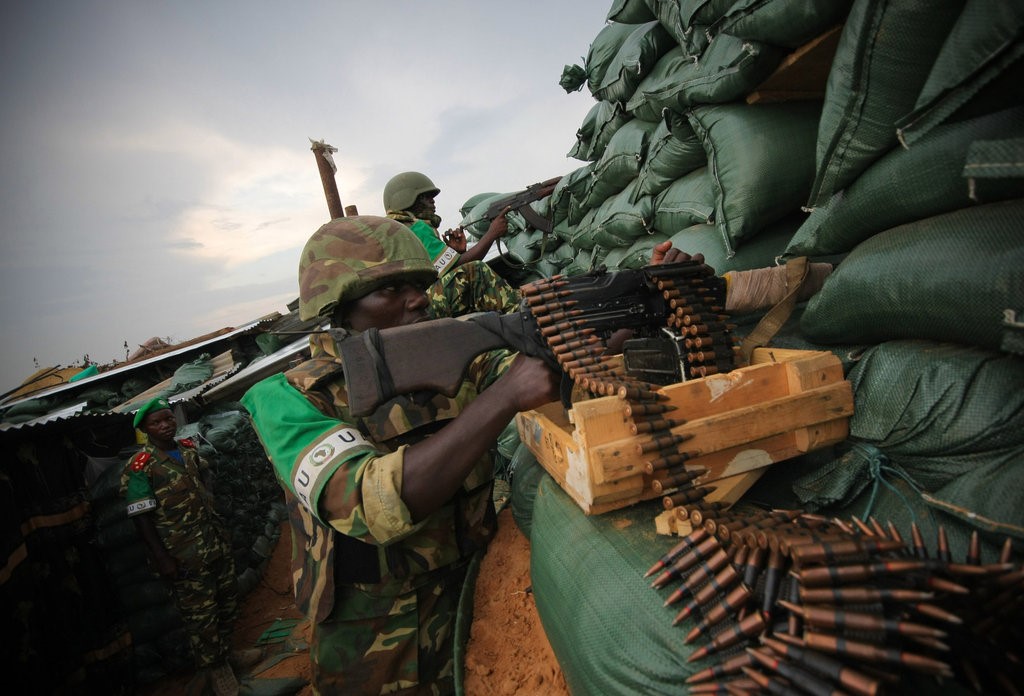 Burundian Troops Man Defensive Line in Mogadishu (AP/Stuart Price)
Burundian Troops Man Defensive Line in Mogadishu (AP/Stuart Price)
